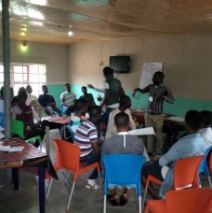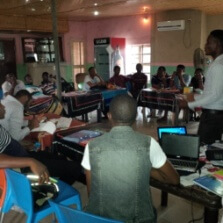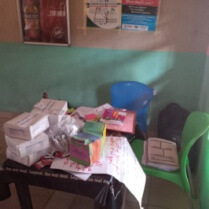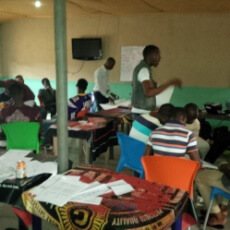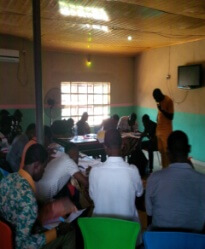PEER HEALTH EDUCATOR CAPACITY BUILDING PROGRAM/TRAINING
One days Peer Educators’ capacity building program was carried out for selected Peer Educators on the HRM target populations in three Local Government Areas (PHALGA, WALGA, and OBALGA) Rivers state. A total of Twenty one (21) participants comprising of Peer Educators, PE supervisors and staff were in attendance.
The purpose of the training is to provide understanding of prevention project and acquire basic skills needed for the implementation of the HIV prevention project for the HRM in Rivers State, Nigeria within the stipulated project period.
Methodologies: methodologies used during training among participants are: presentation, brainstorming, facilitation, role plays, group work, question and answer etc. Ground rules were set for proper coordination during the course of the training. Recollecting participant’s expectations and concerns included:
Expectations:
(1) to be able to educate people on how to take care of their health.
(2) To be informed, educated and be vast in the area of HIV/AIDs and it spread.
(3) To be educated on how I can educate others on HIV/AIDs.
(4) To be able to change people’s negative attitudes towards PLHIV
(5) To get all information necessary as regards the purpose of the training.
Concerns:
(1) About the alarming rate by which HIV/AIDs is been spread and lack of information in the Society
(2) How long we are going to operate
(3) About the alarming rate at which young people living with HIV/AIDs and the discrimination of people living with HIV/AIDs.
(4) About the benefit of the training.
The training tools used included: training registration forms used to capture participants details on arrival, pre and post test forms, training manual, final evaluation, and participant’s attendance and payment sheets were used to capture other relevant data.
Good will messages: The Program Officer in his remarks stated that Rivers State HIV prevalence is 15.2% and participants our work as Peer educators should be intensified to ensure a drop in the state’s HIV prevalence rate, he also emphasized on the need for HTC as entry point to HIV prevention and care and treatment. The M&E Officer gave some words of encouragement to the participants emphasizing on proper documentation and reporting. He encouraged Peer Educators to ensure consistency in names and signatures of their peers. The Program Officer commended the Peer Educators and urged them to give their full support to make the HIV prevention Project a success. He gave an update of the training with emphasis still on the Peer Educators reporting sheets. Emphasis was made on recruiting core target populations for the project. Peer Educators should ensure they recruit member of the target group
Pre and post test: Pre test was conducted to access baseline knowledge of participants at the beginning of the training. Post test was used to measure the participants increase in knowledge at the end of the training. Participants performance at pre test was generally low, however, results from post test showed a high increase in knowledge.
Presentations:
KAREEM WASIU BOBY. the Executive Director the session on Concept of Peer Education, the M&E Officer also facilitated the session on M&E tools, reporting and documentation. Other toptics facilitated by trainers included: Introduction to Communication in HIV Intervention, Hiv Prevention and Human Rights, Relationship between STIs and HIV.
Knowledge of HIV/AIDs and STI; definition of the terms HIV & AIDs. Brief overview of Signs and symptoms of STI, HIV transmission and prevention. Sexual diversity, alcohol and drug abuse and sexually transmitted infections. Concept of Peer education; definition of peer education, who is a peer educator? Importance of peer education in HIV prevention. Roles of peer educators.
Minimum prevention Package intervention (MPPI); peer education, peer education plus and community awareness. What is expected of the Peer educators, M&E tools and reporting activities of peers.
PEP Entry, intensive and exit phase activities were explained to participants. Emphasis on advocacy and peer recruitment as major activities under the entry phase were clearly explained to participants.
Behavioural, Biomedical and Structural strategies of intervention used to reach peers under the intensive phase of intervention were explained according to their activities such as: peer education sessions, drama, quiz, sporting activities, Inter Personal Communication (IPC) interactive forum, film shows, condom messaging and distribution, referral and linkages for HTC and STI services, mobile HIV Counselling and Testing (HTC), condom forecasting and quantification, community dialogue, Income Generating Activities (IGAs), Crisis Response, The importance of monitoring as it relates to the identification of project weaknesses and strengths as well as review of project targets was emphasized. Emphasis on applying the Behavioural, Bio medical and Structural strategies of interventions in reaching key populations was highlighted.
Questions & Answers:
- No minor should be recruited into any prevention tool, minimum age is 18years and above.
For now non but as the project precedes more things would be provided for but IEC materials are available.
Final Evaluation: Final evaluation was used to access participant’s satisfaction with training logistics, facilitation, knowledge learned and welfare.
Participant’s responses were collated and recorded in percentages under their various domains below:
Strongly Agree | Agree | Neutral | Disagree | Strongly Disagree | |
The training met my expectations | 72.2% | 27.3% | – | – | – |
I will be able to apply the knowledge learned | 82% | 18.2% | – | – | – |
The training objectives for each topic were identified and followed | 72.2% | 27.3% | – | – | – |
the content was organized and easy to follow | 72.2% | 27.3% | – | – | – |
The materials distributed were relevant and useful | 63.6% | 36.3% | – | – | – |
The trainer was knowledgeable | 100% | – | – | – | |
The quality of instruction was good | 72.2% | 27.3% | – | – | – |
The trainer met the training objectives | 72.7% | 27.3% | – | – | – |
Class participation and interaction were encouraged | 63.6% | 36.3% | – | – | – |
Adequate time was provided for questions and discussion | 72.7% | 18.1% | 9.1% | – | – |
Excellent | Good | Average | Poor | Very poor | |
How do you rate the training overall? | 81.8% | 18.2% | – | – | – |
Questions & Answers:
Time management and feeding, Transport allowance and more materials.
Achievements/Training outcome:
- Common understanding of the Prevention project amongst participants
- Good understanding of the basic skills required for the implementation of the project for key populations
- Peer Educators are trained in relevant health information and communication skills to engage their peers in conversations about the issue of concern, seeking to promote health-enhancing knowledge and skills in their communities.

